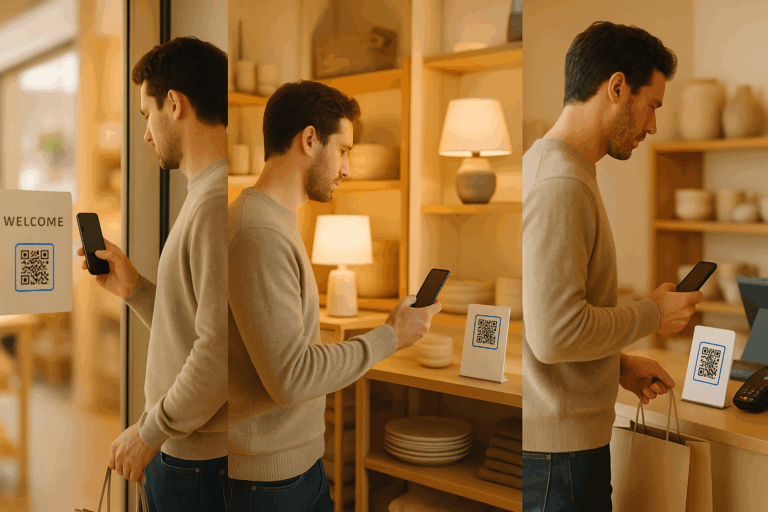You’re running a successful chain of boutiques, but your “tech stack” looks like a digital junk drawer. Loyalty points live in one app that crashes every Tuesday. Coupons get managed in Excel (yes, still). Marketing campaigns run through Mailchimp, but good luck connecting that data to your actual sales. Your CRM? Half-empty and wholly ignored.
Sound familiar? You’re not alone, and you’re definitely not failing. You’re just operating with what most small and mid-sized retailers have: limited budgets, no IT department, and a retail tech stack built from whatever seemed cheapest at the time.
The truth is: while enterprise retailers throw thousands at Oracle and Salesforce, you’re stuck playing digital Jenga with subscription services that don’t talk to each other. Meanwhile, customers expect seamless experiences across every touchpoint.
The pressure is real, but the solution doesn’t have to be complex.
The Hidden Cost of Running a Frankenstein Tech Stack
Let’s talk about what that fragmented approach is actually costing you. Spoiler: it’s more than you think.
Staff Are Drowning in Logins and Workarounds
Your team spends the first 20 minutes of every shift logging into different systems. The loyalty app requires one password, the coupon platform needs another, and don’t get started on trying to update customer profiles across three different databases. When Sarah from your Manchester store calls asking why Mrs. Henderson’s birthday discount isn’t showing up, someone has to manually cross-reference four different platforms to figure out what went wrong.
You can’t run a business when you’re babysitting your software.
Customer Experience Gaps Are Costing Sales
Does this sound at all familiar? A regular customer earns loyalty points buying a jacket in-store, but when she tries to use those points online three days later, her balance shows zero. Your staff have to manually add the points because your systems don’t sync overnight like they’re supposed to. Your brand looks disorganised, and customers start shopping elsewhere for convenience.
According to recent retail studies, 52% of users have switched from brands they were loyal to due to a bad experience. When your retail tech stack creates that friction, you’re literally paying to lose customers.
The Subscription Creep Is Real
Those “affordable” monthly subscriptions add up faster than coffee purchases. £29 for email marketing here, £45 for loyalty management there, another £60 for customer analytics that only works if someone remembers to export data from your POS every week. Before you know it, you’re spending £2,000+ monthly on tools that create more work than they solve.
Add integration costs (because nothing connects natively), consultant fees (because nobody understands how it all fits together), and the time your team wastes switching between systems, and suddenly that “budget-friendly” approach looks expensive.
What Retailers Actually Need in 2025
You deserve better. Way better. Start by prioritizing these essentials when building your retail tech stack:
All-in-One Beats Best-of-Breed Every Time
The days of “best tool for each job” are over for SME retail. You need fewer vendors, simpler operations, and one throat to choke when something goes wrong. Unified platforms that handle loyalty, customer data, marketing automation, and payment processing in one place aren’t just convenient – they’re strategic.
POS Integration Is Non-Negotiable
If your loyalty program requires manual data entry, bin it. If your marketing platform can’t automatically capture purchase behaviour from your point of sale, it’s useless. Customer identification and purchase tracking should happen seamlessly at checkout, feeding everything else in your stack.
True Omnichannel Flexibility
Your customer account should work the same way whether someone shops online, in-store, or through your mobile site. Same points balance, same purchase history, same personalised offers. If you’re still managing separate systems for different channels, you’re fighting yesterday’s battle.
Speed of Implementation Matters
You can’t afford 18-month rollouts when you need affordable retail software that delivers results quickly. Look for solutions that go live in weeks, not quarters. Your business moves fast, and your tech stack should keep up. If a vendor can’t get you operational in 30-45 days, find one that can.
ROI-Focused Investment
Every euro spent on your retail tech stack should demonstrate measurable impact on customer retention, average order value, or repeat purchase rates. Vanity metrics don’t pay rent.

The Rise of Unified Customer Engagement Platforms
Smart retailers are abandoning the patchwork approach entirely. Instead of juggling separate tools for CRM, loyalty programs, email marketing, and voucher management, they’re moving to integrated platforms that handle everything through a single interface.
Think of it like switching from having five different apps on your phone to one super-app that does it all. Same functionality, fraction of the complexity.
These unified platforms embed directly into your existing POS system, capturing customer data automatically and enabling staff to manage everything from one screen. When a customer makes a purchase, their loyalty points update instantly, their email preferences sync automatically, and personalised offers generate based on real purchase behaviour.
The old way meant training staff on multiple systems, managing multiple vendor relationships, and constantly fighting integration issues. The new way means one system, one training session, and one monthly invoice. And everyone’s happier for it.
Where to Invest Your Limited Budget for Maximum ROI
Not all retail technology investments are created equal. Put your money where it counts:
Customer Identification at Every Touchpoint
Before you can retain customers, you need to know who they are. Invest in systems that capture customer information seamlessly at checkout – through phone numbers, email addresses, or digital wallet integration. This unlocks everything else: purchase history, preferences, and the ability to create personalised experiences.
Also Read: Customer Engagement Metrics in Retail: What to Track and Why
Integrated Loyalty and Rewards Programs
Repeat customers drive 80% of revenue for retailers, yet many still run loyalty programs that feel like afterthoughts. Your loyalty solution should integrate with your POS, work across all channels, and provide instant gratification.
Omnichannel Vouchers and Gift Cards
Digital vouchers and gift cards do double duty: they attract new customers and bring existing ones back. But only if they work everywhere your customers shop. Invest in voucher solutions that sync across online and offline channels, track redemption automatically, and integrate with your existing payment processes.
Marketing Automation Connected to Purchase Data
Email marketing that says “We miss you!” to someone who shopped yesterday is embarrassing. Invest in automation tools that use actual purchase behaviour to trigger relevant communications. When someone buys running shoes, they should get related running gear recommendations, not random product blasts that may/may not have anything to do with their lifestyle.

The Smarter Alternative: All-in-One Customer Engagement
Time to consolidate your entire customer engagement strategy into a single, integrated platform.
These solutions combine loyalty management, customer communications, voucher handling, and analytics into one POS-connected system. Implementation takes weeks instead of months, staff training happens once instead of continuously, and customer data flows seamlessly across every interaction.
This is where Avian comes in. We’ve built a complete loyalty and customer engagement solution that integrates directly with your existing POS system, requiring no additional hardware and going live in under 30 days.
Avian consolidates everything you need: points-based loyalty programs, automated customer communications through WhatsApp and email, digital vouchers and gift cards, stored value wallets, and comprehensive customer analytics – all managed through one interface that your staff will actually want to use.
The platform is designed specifically for European retailers, with full GDPR compliance built in, EU-based hosting, and support for the communication channels your customers actually use. No apps required, no complex integrations, and no ongoing technical headaches.
Ready to simplify your retail tech stack without sacrificing functionality?
Book a demo to see how Avian can replace your fragmented tools with one elegant solution that saves time, reduces costs, and creates better customer experiences from day one.
- How much should a small retail business budget for tech stack costs in 2025?Most successful SME retailers allocate 2-4% of revenue to their complete tech stack, including POS, loyalty, marketing automation, and customer management. However, the key isn't how much you spend - it's eliminating redundant subscriptions. Many retailers cut their monthly tech costs by 40-60% when they consolidate from 5-8 separate tools into one unified platform.
- What's the fastest way to implement loyalty and customer engagement without disrupting operations?Look for POS-integrated solutions like Avian that require zero additional hardware and can go live within 30 days. The fastest implementations happen when your loyalty program embeds directly into your existing checkout process - no staff retraining on separate systems, no customer app downloads, and no complex integrations that break your current workflow.
- How do I know if my current retail software is actually driving customer retention?Track three metrics: repeat purchase rate, average time between visits, and customer lifetime value. If your current tools can't measure these automatically from your POS data, you're flying blind. Effective retail software should show you which customers are at risk of churning and automatically trigger retention campaigns based on actual purchase behaviour.
- How can small retailers compete with enterprise-level customer experiences on a limited budget?Focus on customer identification at every touchpoint and automated personalisation based on purchase history. Enterprise retailers spend millions on complex CRM systems, but SMEs can achieve similar results by ensuring every transaction captures customer data and triggers relevant follow-up communications. The key is choosing technology that automates personalisation without requiring dedicated marketing staff or expensive consultancy fees.
- If I already have a loyalty program or CRM, do I need to replace everything to use Avian?Not at all. Avian is built to work with what you already have. Many retailers start with one or two existing solutions in place - like a loyalty program or CRM - and use Avian to fill the missing pieces. Because it’s API-enabled and POS-integrated, Avian can run alongside your current setup or gradually replace fragmented tools over time. No need for a painful rip-and-replace.









